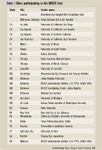Article
Study explores corticosteroid implant treatment for uveitis
The Multicenter Uveitis Steroid Treatment (MUST) trial is a National Eye Institute-sponsored phase IV study comparing the fluocinolone acetonide 0.59-mg implant (Retisert, Bausch & Lomb) with standard systemic therapy for the treatment of noninfectious intermediate, posterior, or panuveitis. Its results are intended to help define the role of implant therapy for the treatment of uveitis. Enrollment is ongoing and referral of potentially eligible patients is encouraged.

Key Points

The National Eye Institute (NEI)-sponsored, open-label trial was launched in December 2005. Twenty-one centers are participating in the United States and single centers each in London and Melbourne, Australia. The study aims to enroll 400 patients with active uveitis who are being randomly assigned 1:1 to receive the fluocinolone acetonide implant therapy or systemic therapy beginning with oral prednisone and adding other immunosup-pressive agents as needed.
Best-corrected visual acuity (BCVA) measured in masked fashion by an assessor using logarithmic charts is being followed as the primary outcome measure for the study. Secondary endpoints include standardized ratings of vitreous haze and intraocular inflammation severity, photographic documentation of retinal morphology, safety assessments to determine the complications of the disease and its treatment, and quality of life.

He encourages ophthalmologists to contact Wilmer if they know of patients who might be eligible for the MUST trial. The Bloomberg School of Public Health at Johns Hopkins is the coordinating center for the study, and the Fundus Photography Reading Center is at the University of Wisconsin, Madison.
The fluocinolone acetonide implant was approved by the FDA in 2005 for the treatment of chronic noninfectious posterior uveitis. Its approval was based on the results of two noncomparative trials that showed it significantly reduced the recurrence of uveitis and the use of adjunctive systemic therapy and periocular corticosteroid injections during 34 weeks of follow-up compared with the same length period prior to implantation. In addition, about 20% of eyes that received the implant benefited with a 3-line or greater improvement in visual acuity after 34 weeks of follow-up.
The treatment was not without its risks, however. About 90% of patients required cataract surgery within 2 years of implantation, 50% of patients needed glaucoma therapy, and about 30% needed glaucoma surgery because their disease was not controlled with medication.

"We do not know from the premarketing clinical trials what are the long-term side effects of the implant, its long-term effect on the underlying disease, and how treated patients fare compared with controls who receive systemic therapy or observation," Dr. Dunn explained.
Newsletter
Don’t miss out—get Ophthalmology Times updates on the latest clinical advancements and expert interviews, straight to your inbox.




